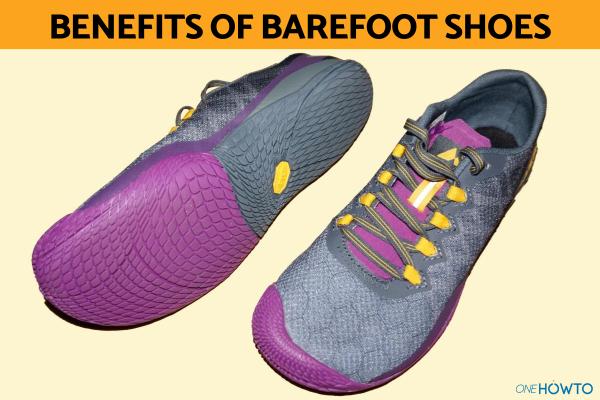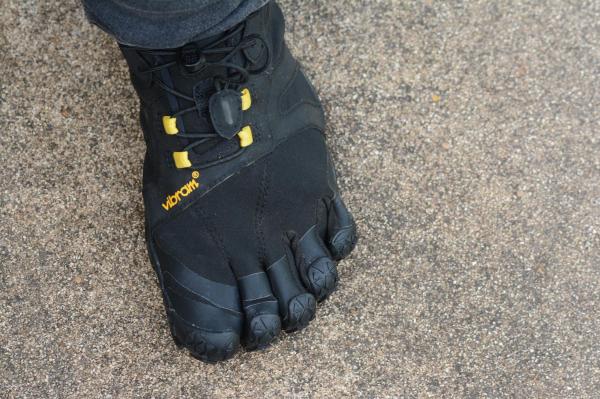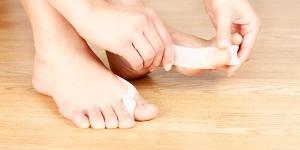The Benefits of Barefoot Shoes


Barefoot shoes are a type of minimalist footwear which are gaining a lot of popularity. For those looking for a healthy and more natural way of walking, barefoot shoes mimic the foot's natural contours to give a feeling as if they are not wearing any shoes at all. While this helps to make the feet move more freely, it still provides the protection against surfaces and the elements. This is particularly important for those of us who are hiking or playing sport, although it is important to provide protection in urban areas.
More than just a fashion preference, oneHOWTO looks at the benefits of barefoot shoes. Some of the advantages of minimalist footwear include improved posture, strengthening of foot muscles, reduced impact on joints and a lower risk of deformities.
What are barefoot shoes?
Barefoot footwear, also known as minimalist footwear, is a type of shoe designed to offer a feeling similar to walking barefoot, but still providing light protection from hard or dangerous surfaces. Unlike conventional footwear, these shoes have very specific features that make them unique:
- Thin and flexible sole: the sole of these shoes is much thinner than that of traditional footwear, allowing the feet to feel the terrain better and adapt to it.
- Zero drop: there is no difference in height between the front and back of the shoe, which keeps the foot in a naturally aligned position.
- Wide toe box: unlike conventional shoes that can compress your toes, barefoot footwear has a wide toe box (the section of footwear around the toes) to allow for free and unrestricted movement.
- No rigid arch support: as there is zero drop, barefoot shoes are designed so that the muscles and tendons of the foot work naturally without relying on artificial support.
- Lightweight and breathable material: they are usually made of materials that allow ventilation and provide comfort without adding extra weight.
The idea behind this type of minimalist footwear is that our feet are designed to move autonomously and naturally. It claims that overuse of traditional shoes can weaken the muscles of the foot and affect our posture.
The transition to barefoot shoes must be done carefully to avoid injury. It is important to choose the right model according to the use you will give them. Over time, many people find that this type of footwear gives them greater comfort and freedom, allowing them to move more naturally and efficiently. However, it is also possible that some may find greater benefit from other types of shoes, e.g. people with fallen arches.
Regardless of the type of footwear you choose, you may want to check out our article on how to stop shoes from squeaking if they have become noisy.

Benefits of barefoot shoes
Barefoot shoes not only provide a more natural walking or running experience, but also offer several potential health benefits. Here are some of the most notable proposed advantages of minimalist footwear:
- Improves posture and balance: by allowing the feet to support the body naturally, without artificial heel elevation, barefoot footwear helps maintain a more aligned posture and improves overall balance. This can prevent back, hip and knee problems.
- Strengthens foot and leg muscles: by providing too much support and cushioning, conventional shoes can cause foot muscles to become weak and dependent on footwear. With barefoot shoes, the muscles work harder and become stronger over time. This may reduce the risk of injury over the long term.
- Reduces impact on joints: walking barefoot or in barefoot shoes causes the feet to adopt a more natural gait pattern, which can reduce the impact on the knees and ankles. This is especially beneficial for runners as it minimizes the risk of repetitive impact injuries.
- Greater sensitivity and connection with the environment: one of the most notable advantages of barefoot footwear is the greater perception of the ground. By having a thin and flexible sole, the feet can feel the terrain better. This improves proprioception (body awareness) and makes movements more precise and natural.
- Reduces the risk of foot deformities: wearing conventional footwear with narrow toe boxes can cause deformities such as bunions, claw toes or plantar fasciitis. By allowing a wider space for the toes, barefoot footwear helps prevent these problems.
- It can reduce chronic pain: many people who suffer from foot, knee or back pain find relief by switching to barefoot footwear, as it promotes a more natural gait that is easier on the joints.
It is very important to stress that barefoot footwear may not provided the same advantages to everybody. If you are dealing with chronic pain, joint issues or other foot problems, speak to a trusted physician about whether changing to minimalist footwear is a good idea for you.

How to choose the right barefoot shoes
If you have decided to try barefoot footwear, it is important to choose the right model according to your lifestyle and needs. Here are some key tips to make the best choice of minimalist shoes:
- Start with a gradual transition: if you've never worn minimalist shoes before, it's a good idea to make the transition slowly. Your feet have been accustomed to support and cushioning for years, so going straight into a barefoot shoe can cause discomfort or injury if not done carefully. One piece of advice is to start by wearing them only for short periods of time and gradually increase your usage.
- Make sure the toe box is wide enough: one of the biggest benefits of barefoot is allowing free movement of the toes. Before purchasing, check that there is enough room in the front so that the toes do not feel cramped.
- Choose flexible, yet durable soles: while the sole should be thin and flexible to allow for a better feel for the ground, it's also important that it offers some resistance to wear and tear. This is especially if you plan to use them for running, hiking or walking on rough terrain.
- Consider material and breathability: choose models that are lightweight and breathable, especially if you're going to wear them in hot weather. There are options in leather or synthetic materials that allow for greater ventilation, often using some kind of mesh material.
- Think about what you'll be using it for: there are different types of barefoot shoes depending on their use. For everyday use, there are casual models with a discreet design that allow for a comfortable and natural experience without losing style. For those who exercise regularly or play sports, there are options with more resistant soles and better grip. You can also find alternatives made with waterproof materials and greater durability if you want to choose barefoot shoes for hiking.
- Try different brands and models: each brand of barefoot footwear has a unique design, so it's worth trying out a few models before settling on the final one. Some of the most well-known brands in this space include Vibram FiveFingers, Xero Shoes, Vivobarefoot and Merrell Barefoot.
Now that you know the benefits of barefoot shoes, you may also be interested in our article on how to stay safe if you go hiking in the mountains.
This article is merely informative, oneHOWTO does not have the authority to prescribe any medical treatments or create a diagnosis. We invite you to visit your doctor if you have any type of condition or pain.
If you want to read similar articles to The Benefits of Barefoot Shoes, we recommend you visit our Family health category.






